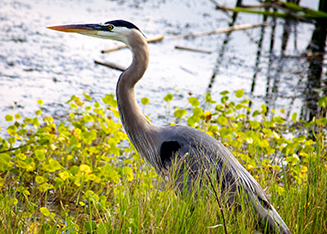Sandhill Cranes
resources
North American sandhill cranes are collectively the most abundant of the world's crane species and are divided into three non-migratory and three migratory subspecies. The non-migratory subspecies (Florida, Cuban and Mississippi) are relatively small populations with restricted ranges, and specialized conservation programs already exist for their management.
The sandhill crane is an ancient North American species with fossil records dating back at least 2.5 million years. They are large, vocal, spectacular birds with unique breeding displays and have become symbols of international cooperation for bird conservation. Sandhill cranes are long-lived, have the lowest recruitment rates (5-15 percent juveniles/total cranes) of any North American game bird, and generally do not breed until age 3-5 years of age. Migratory sandhill cranes occupy a vast range that includes Russia (Siberia), Canada, the United States, and Mexico. Historically, sandhill cranes were thought to be comprised of three subspecies (greater, Canadian, and lesser).
For management purposes, migratory sandhill cranes have been grouped into six populations for management purposes, despite their subspecies affiliation: Central Valley, Eastern, Lower Colorado River Valley, Mid-Continent, Pacific Coast (also called the Pacific Flyway), and the Rocky Mountain Populations. The Mid-Continent Population is comprised of both subspecies of sandhill cranes, whereas the other populations are comprised almost exclusively of either the greater or lesser subspecies. More information on the sandhill crane is in our current funding strategy(1.1MB).

Sandhill crane populations in North America
Sandhill Crane, A Funding Strategy(1.1MB)
This strategy was developed in 2009 by the Association of Fish and Wildlife Agencies' Migratory Shore and Upland Game Bird Support Task Force. It contains recommendations for obtaining priority information needed to improve habitat and harvest management decisions for migratory populations of sandhill cranes, focusing on evaluating and improving knowledge of monitoring efforts, vital rates (survival, reproduction and recruitment), and habitat needs during the annual cycle of these birds. The strategy is intended to increase financial support for management and research activities over the next 5 to 10 years with thoughtful and deliberate planning built on basic scientific principles.
Sandhill Crane, Status and Harvests of Sandhill Cranes (2MB)
This report provides population status, recruitment indices, harvest trends, and other management information for the Mid-Continent, Rocky Mountain, Lower Colorado River Valley, and Eastern populations of sandhill cranes.
Coordinated Spring Survey Of Mid-Continent Sandhill Cranes (237.7KB)
This report provides population status for mid-continent sandhill cranes. Aerial transect coverage includes Nebraska’s Platte and North Platte River valleys. Ground coverage efforts focus in areas of traditional crane use/occurrence within the states of Nebraska, Kansas, and Texas.
Sandhill Crane Management Plans
Individual species management plans are products of Flyway Councils and developed to guide state, provincial, and federal agencies cooperatively manage migratory birds. Within management plans are non-legal binding recommendations which agencies agreed to guide management decisions. These Flyway Councils have prepared management plans for most migratory game bird species in North America. To date there are plans for six North American migratory populations of sandhill cranes (Eastern, Mid-Continent, Rocky Mountain, Lower Colorado River Valley, Central Valley, and Pacific).
Final Reports & Abstracts for Projects Funded through the Webless Migratory Game Bird Program
This program was designed to provide cooperative funding for both research and management activities from the U.S. Fish and Wildlife Service, state wildlife agencies, and other sources for projects benefitting mourning and white-winged doves, hunted rails (sora, clapper, king and Virginia) and Wilson's snipe, sandhill cranes, American woodcock, American coots, common moorhens, and purple gallinules, and band-tailed pigeon, scaly-naped pigeon, Zenaida dove, and white-tipped dove. The Webless Migratory Game Bird funding program has proved to be invaluable in providing much-needed funding for webless species that receive considerably less attention than waterfowl. The purpose of the program abstracts and reports is to provide updated information on Webless Migratory Game Bird Program funded projects. Projects completed through the program have resulted in improved knowledge and management of webless migratory game birds.
(Project Abstracts: 2004-2011)
(Final Reports: 2012 - present are listed below)
-
Dispersal And Population Genetic Structure In Two Flyways Of Sandhill Cranes (Grus Canadensis) (4.5MB)
Distribution, Migration Chronology, and Survival Rates of Eastern Population Sandhill Cranes (1.4MB)
Population Genetic Structure In The Eastern Population Of Greater Sandhill Cranes (Grus Canadensis Tabida) (4.2MB)
Reproductive Success and Survival in the Eastern Population of Sandhill Cranes (1.1MB)
Lower Colorado River Valley Sandhill Crane (Grus canadensis) Breeding and Wintering Ecology (1.6MB)
Delineating Sandhill Crane Populations in Minnesota (467KB)
Estimating Annual Survival Rates from Sparse Band-recovery Data: Examples from Migratory Shore and Upland Gamebirds ( bytes)
Additional Sandhill Crane resources can be located at:
International Crane Foundation
Rowe Sanctuary
Bosque del Apache NWR
Tennessee Sandhill Crane Festival


